Iya (Indonesia) | 30 October-5 November 2024 | New Activity / Unrest
 Cite this Report Cite this Report
|
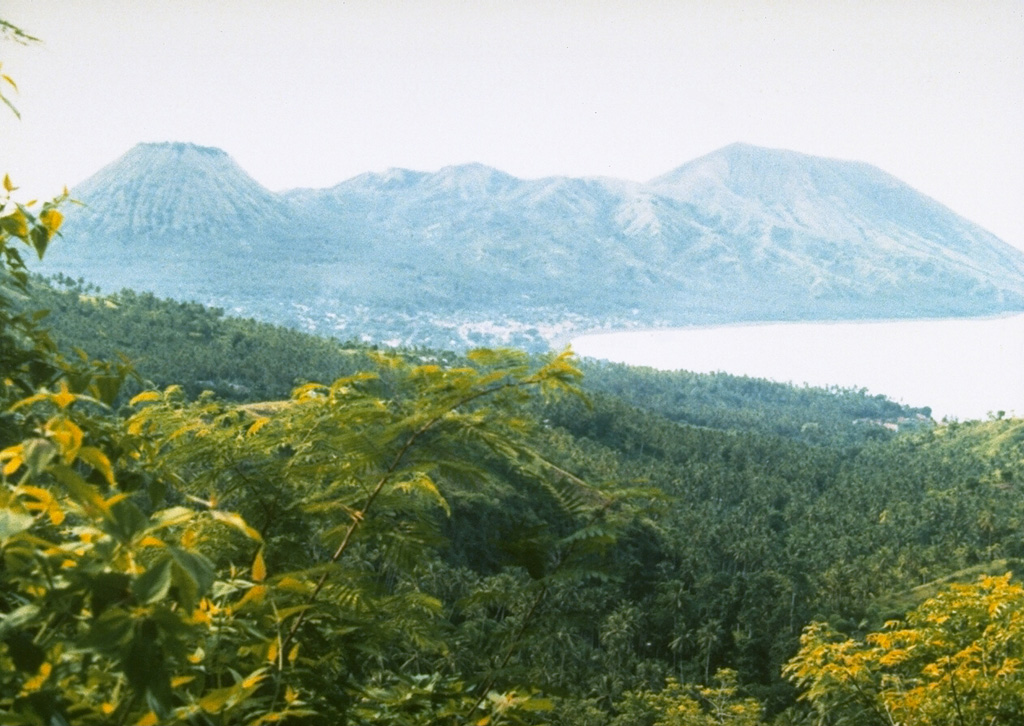 Iya Iya
Sunda Volcanic Arc
|
The Pusat Vulkanologi dan Mitigasi Bencana Geologi (PVMBG) reported that daily white emissions at Iya rose as high as 350 m above the cater rim and drifted in several directions during 30 October-5 November. At 1800 on 5 November the Alert Level increased from 2 to 3 (on a scale of 1-4) due to increased seismic activity, and the public was warned to stay 3 km away from the active crater area in all directions and 5 km away to the south.
Source: Pusat Vulkanologi dan Mitigasi Bencana Geologi (PVMBG, also known as CVGHM)
|
Kama'ehuakanaloa (United States) | 30 October-5 November 2024 | New Activity / Unrest
 Cite this Report Cite this Report
|
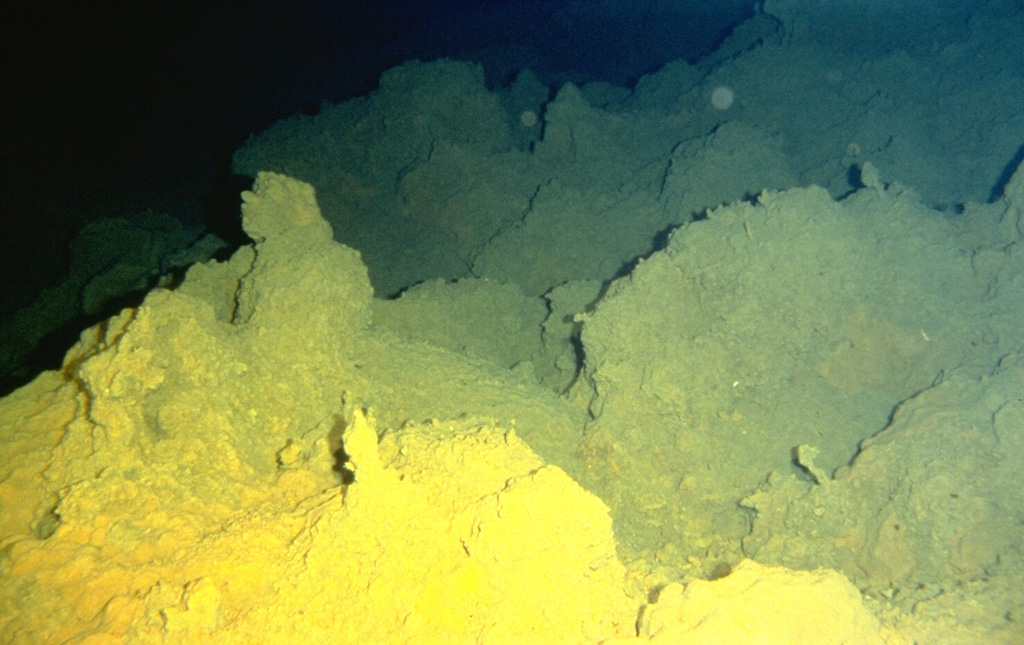 Kama'ehuakanaloa Kama'ehuakanaloa
Hawaiian-Emperor Hotspot Volcano Group
|
HVO reported that Kamaehuakanaloa volcano (formerly Loihi Seamount), located offshore SE of the Island of Hawaii, began a period of heightened seismic unrest at around 1800 on 1 November. A swarm of more than 70 earthquakes occurred, with 32 events being greater than M 2.0 and two events greater than M 4.0. The largest earthquake, a M 4.3 event, occurred at 1205 on 2 November at a depth of 5.8 km (3.6 miles) below sea level and 4.8 km (3.0 miles) below the summit. There was only one report of someone feeling the earthquake. Seismic activity slightly declined later that day around midnight, though it remains above background levels as of 2 November. The Alert Level remained at Unassigned and the Aviation Color Code remained Unassigned as well.
Source: US Geological Survey Hawaiian Volcano Observatory (HVO)
|
Lewotobi (Indonesia) | 30 October-5 November 2024 | New Activity / Unrest
 Cite this Report Cite this Report
|
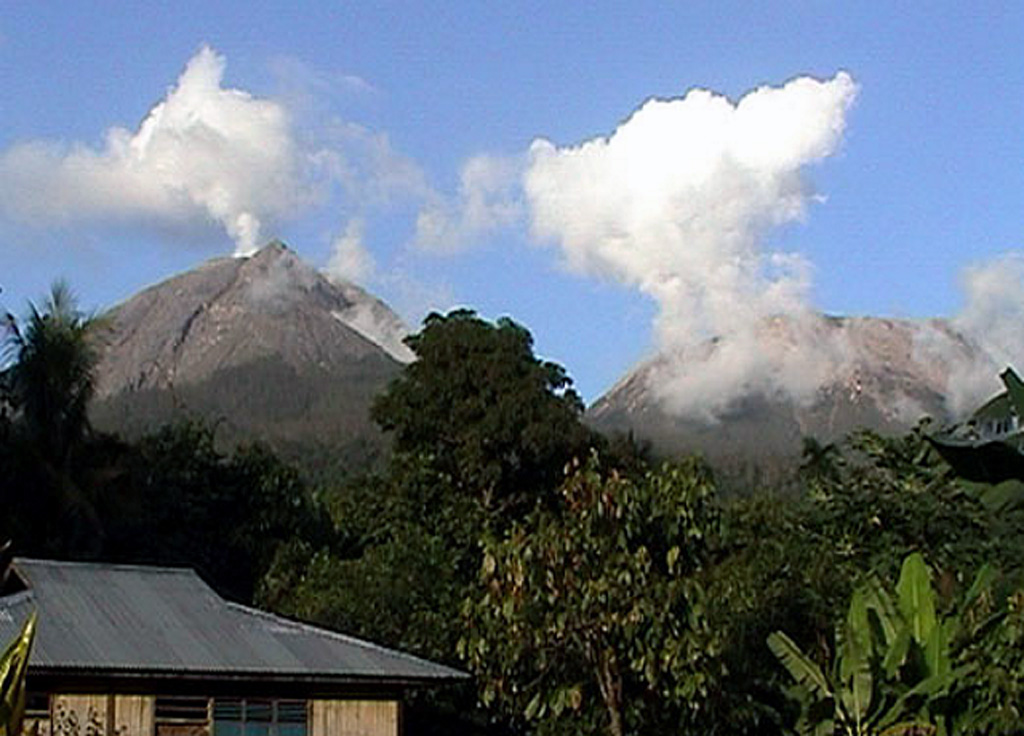 Lewotobi Lewotobi
Sunda Volcanic Arc
|
The Pusat Vulkanologi dan Mitigasi Bencana Geologi (PVMBG) reported that eruptive activity intensified at Lewotobi Laki-laki during 30 October-5 November, which included a major eruption resulting in fatalities. The large explosive eruption began at 2357 on 3 November, generating pyroclastic flows that traveled down the flanks in all directions, ejecting ballistic projectiles, and forming a large vent within the summit crater. Seismic data indicated that the explosion lasted about 24 minutes, until 0021 on 4 November. Darkness prevented direct ash plume observations, but the Darwin VAAC issued an aviation advisory for ash to 12 km altitude (10.3 km above the summit) based on infrared data from the HIMAWARI-9 satellite. Within 3 minutes of the eruption onset, at 0000 on 4 November, the Alert Level was raised to Level 4 (the highest on a four-level scale), the Aviation Color Code was elevated from Orange to Red (the highest on a four-color scale), and the hazard exclusion zone was expanded to a 7-km radius around both the Laki-laki and Perempuan craters.
The BNPB Operations Control Center (Pusdalops) reported at 0745 on 5 November that nine people had died as a result of the eruption, one person was in critical condition, and 63 others had serious or minor injuries. At least six of those who died came from Klatanlo Village, 3 km NW of the summit. As many as 10,295 people, or 2,734 families, were evacuated to unaffected areas 15-20 km from the volcano. Many areas were covered in ash, incandescent ejecta started fires in residential areas, and homes were damaged within a 7-km radius. There were six villages affected in Wulanggitang District (Pululera, Nawokote, Hokeng Jaya, Klatanlo, Boru, and Boru Kedang), four villages in the Ile Bura District (Dulipali, Nobo, Nurabelen, and Riang Rita), and four villages in the Titehena District (Konga, Kobasoma, Bokang Wolomatang, and Watowara). Multiple impact craters from ballistic ejecta were discovered, with the furthest reported at 7 km; one at an unreported location measured approximately 13 m wide and 3 m deep.
Ash from the eruptions disrupted airspace navigation around Fransiskus Xaverius Seda Airport, Bajawa Soa Airport, H. Hasan Aroeboesman Airport, Frans Sales Lega Airport, Komodo International Airport, Gewayantana Airport, Wunopito Airport, and Pantar Kabir Airport, which led to the cancellation of several flights. By 1600 on 4 November, all airports resumed flights, except for Komodo International Airport, which remained closed until 0630 on 5 November.
Explosions continued on 4 November, with five events producing ash plumes that reached at least 300 m above the summit and incandescent material visible in nighttime webcam images. A total of three explosions were recorded on 5 November, which produced ash plumes that rose to 1 km above the summit.
Prior to the major 3-4 November events, eight explosions recorded during 30-31 October produced ash plumes that reached approximately 1 km above the summit. On 1 November, PVMBG reported a significant increase in the number of deep volcanic earthquakes, and another eight explosions generated ash plumes that reached approximately 2 km above the summit. Explosive activity continued to increase, with Strombolian explosions at 0250 and 0420 generating eruption columns that reached 1.5-2 km above the summit; lightning was observed within the eruption columns. No explosions were recorded between 2359 on 1 November and 2357 on 3 November, although seismicity remained elevated.
Sources: Pusat Vulkanologi dan Mitigasi Bencana Geologi (PVMBG, also known as CVGHM), Antara News, Darwin Volcanic Ash Advisory Centre (VAAC), Badan Nacional Penanggulangan Bencana (BNPB), Radio Republik Indonesia
|
Taal (Philippines) | 30 October-5 November 2024 | New Activity / Unrest
 Cite this Report Cite this Report
|
 Taal Taal
Taiwan-Luzon Volcanic Arc
|
The Philippine Institute of Volcanology and Seismology (PHIVOLCS) reported daily volcanic earthquakes and occasional volcanic tremor events at Taal that lasted 4-14 minutes at a time. Weak-to-voluminous emissions rose as high as 2.7 km above the crater and drifted several directions. The Alert Level remained at 1 (on a scale of 0-5), and PHIVOLCS reminded the public that the entire Taal Volcano Island was a Permanent Danger Zone (PDZ) and recommended that the Main Crater and areas along the Daang Kastila fissure should remain prohibited.
Source: Philippine Institute of Volcanology and Seismology (PHIVOLCS)
|
Aira (Japan) | 30 October-5 November 2024 | Continuing Activity Cite this Report Cite this Report |
 Aira Aira
Ryukyu Volcanic Arc
|
The Japan Meteorological Agency (JMA) reported ongoing eruptive activity at Minamidake Crater (Aira Caldera’s Sakurajima volcano) during 28 October-4 November. Nightly crater incandescence was visible in webcam images. Very small eruptive events were recorded and on 1 November at 0818 an explosion generated an ash plume that rose 1 km above the crater rim and drifted NW. Large blocks were ejected about 400 m from the crater toward the 9th station. The Alert Level remained at 3 (on a 5-level scale), and the public was warned to stay 1 km away from both craters.
Source: Japan Meteorological Agency (JMA)
|
Ambrym (Vanuatu) | 30 October-5 November 2024 | Continuing Activity Cite this Report Cite this Report |
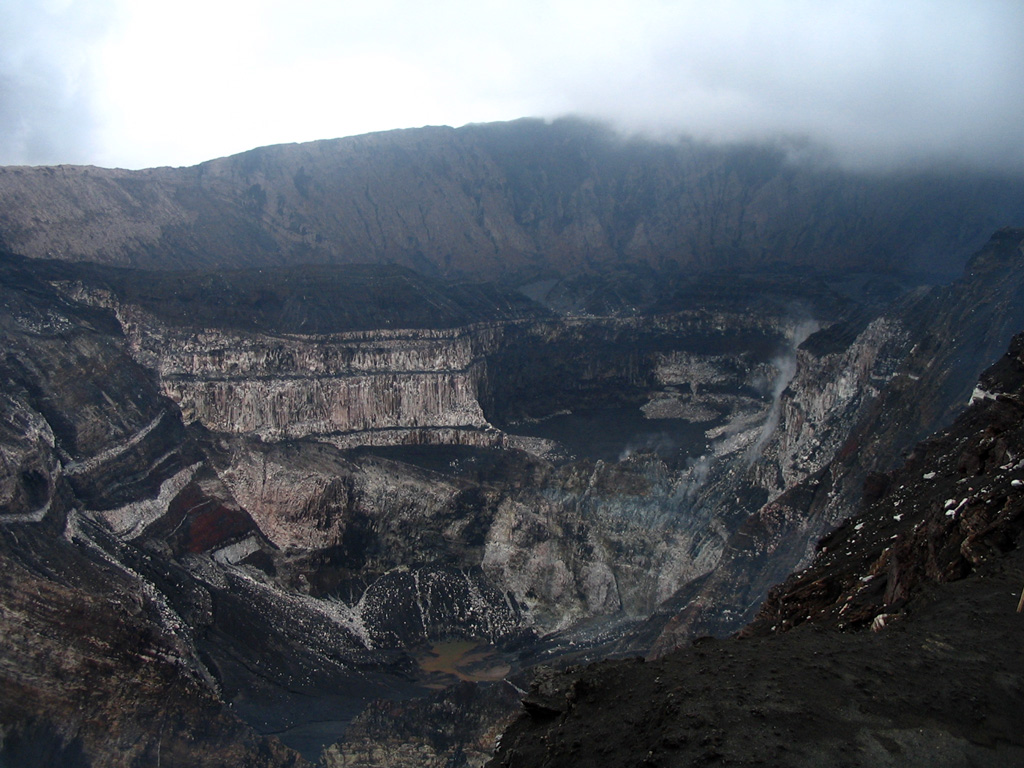 Ambrym Ambrym
Vanuatu Volcanic Arc
|
On 1 November, the Vanuatu Meteorology and Geo-Hazards Department (VMGD) reported ongoing fumarolic activity at Ambrym from both Benbow and Marum craters based on webcam images, as well as satellite images acquired on 31 October. Satellite images also indicated moderate thermal anomalies. Incandescence was observed during the night of 31 October, and seismic activity continued. The Alert Level remained at 2 (on a scale of 0-5). VMGD warned the public to stay outside of Permanent Danger Zone A, defined as a 1-km radius around Benbow Crater and a 2-km radius around Marum Crater, and to stay 500 m away from the ground cracks created by the December 2018 eruption.
Source: Vanuatu Meteorology and Geohazards Department (VMGD)
|
Dukono (Indonesia) | 30 October-5 November 2024 | Continuing Activity Cite this Report Cite this Report |
 Dukono Dukono
Halmahera Volcanic Arc
|
The Pusat Vulkanologi dan Mitigasi Bencana Geologi (PVMBG) reported that explosive activity continued at Dukono during 30 October-5 November. Emissions were observed daily; white-and-gray emissions rose as high as 800 m above the summit. Seismicity included volcano-tectonic (VT) earthquakes, continuous tremor, and 187-248 daily explosion events. The Alert Level remained at Level 2 (the second level on a four-level scale), and the public was warned to stay outside of the 3-km exclusion zone.
Source: Pusat Vulkanologi dan Mitigasi Bencana Geologi (PVMBG, also known as CVGHM)
|
Ebeko (Russia) | 30 October-5 November 2024 | Continuing Activity Cite this Report Cite this Report |
 Ebeko Ebeko
Kuril Volcanic Arc
|
The Kamchatkan Volcanic Eruption Response Team (KVERT) reported that moderate explosive activity was ongoing at Ebeko during 24-31 October. According to volcanologists in Severo-Kurilsk (Paramushir Island, about 7 km E), explosions on 25 October generated ash plumes that rose as high as 2.0 km (~6,600 ft) a.s.l. and drifted NE. Satellite data indicated that either no activity was observed, or weather conditions prevented views. The Aviation Color Code remained at Orange (the third level on a four-color scale). Dates are UTC; specific events are in local time where noted.
Source: Kamchatkan Volcanic Eruption Response Team (KVERT)
|
Fuego (Guatemala) | 30 October-5 November 2024 | Continuing Activity Cite this Report Cite this Report |
 Fuego Fuego
Central America Volcanic Arc
|
Instituto Nacional de Sismologia, Vulcanologia, Meteorologia, e Hidrologia (INSIVUMEH) reported that eruptive activity continued at Fuego during 30 October-5 November. Daily explosions were recorded by the seismic network at rates of 3-11 per hour. The explosions generated gas-and-ash plumes that rose over 1 km above the summit and drifted as far as 30 km SW and W. Weak-to-moderate rumbling sounds and shock waves from explosions were occasionally reported. The explosions also generated weak-to-moderate block avalanches around the crater and often descended toward the Las Lajas (SE), Seca (W), Taniluya (SSW), and Ceniza (SSW) drainages and sometimes reaching vegetated areas. On most days, explosions ejected incandescent material up to 350 m above the summit. Ashfall was reported in Panimache (8 km SW), Morelia (10 km SW), Santa Sofia (12 km SW), Yucales (12 km SW), and other nearby communities on 31 October, and in Panimache (8 km SW), Morelia (10 km SW), Finca la Asunción (12 km SW), Ozuna (12 km SW), La Rochela (8 km SW) and Ceilán (9 km S) on 5 November.
Source: Instituto Nacional de Sismologia, Vulcanologia, Meteorologia, e Hidrologia (INSIVUMEH)
|
Great Sitkin (United States) | 30 October-5 November 2024 | Continuing Activity Cite this Report Cite this Report |
 Great Sitkin Great Sitkin
Aleutian Ridge Volcanic Arc
|
The Alaska Volcano Observatory (AVO) reported that slow lava effusion continued to feed a thick lava flow in Great Sitkin’s summit crater during 31 October-5 November. The lava flow had filled most of the summit crater with minor advancement in the northern part of the east lobe. The local seismic network continued to detect small earthquakes associated with the ongoing eruption. Weather clouds often obscured webcam and satellite views of the summit, but on clear days steaming and elevated surface temperatures were observed. The Volcano Alert Level remained at Watch (the third level on a four-level scale) and the Aviation Color Code remained at Orange (the third color on a four-color scale).
Source: US Geological Survey Alaska Volcano Observatory (AVO)
|
Ibu (Indonesia) | 30 October-5 November 2024 | Continuing Activity Cite this Report Cite this Report |
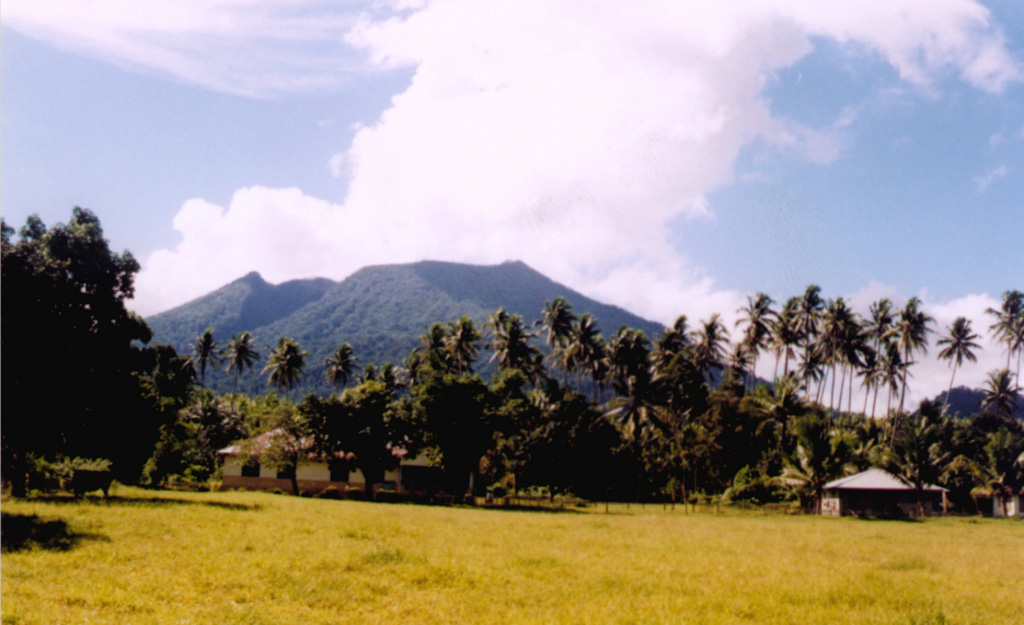 Ibu Ibu
Halmahera Volcanic Arc
|
The Pusat Vulkanologi dan Mitigasi Bencana Geologi (PVMBG) reported that explosive activity continued at Ibu during 30 October-5 November. Emissions were observed daily; white plumes rose as high as 300 m above the summit and ash plumes produced by explosion events rose as high as 800 m above the summit. Seismicity included harmonic tremor episodes, volcanic earthquakes, rockfall events, frequent gas emission signals, tornillo earthquakes, and 67-101 daily explosion events. The Alert Level remained at 3 (the third level on a four-level scale) and the public was advised to stay 4 km away from the active crater and 5 km away from the N crater wall opening.
Source: Pusat Vulkanologi dan Mitigasi Bencana Geologi (PVMBG, also known as CVGHM)
|
Kanlaon (Philippines) | 30 October-5 November 2024 | Continuing Activity Cite this Report Cite this Report |
 Kanlaon Kanlaon
Negros-Sulu Volcanic Arc
|
The Philippine Institute of Volcanology and Seismology (PHIVOLCS) reported continuing unrest at Kanlaon during 30 October-5 November. The seismic network recorded daily volcanic earthquakes, but between 0000 and 1030 on 31 October a total of 64 volcano-tectonic (VT) earthquakes were recorded with maximum magnitude of M 2.9 concentrated 2-8 km beneath the W flanks of the volcano. Sulfur dioxide emissions ranged from 2,066 to 7,087 tonnes per day. On most days voluminous emissions with intermittent ash were observed rising as high as 900 m above the summit and drifting several directions. The Alert Level remained at 2 (on a scale of 0-5) and PHIVOLCS reminded the public to remain outside of the 4-km-radius Permanent Danger Zone and warned pilots not to fly close to the volcano.
Source: Philippine Institute of Volcanology and Seismology (PHIVOLCS)
|
Karymsky (Russia) | 30 October-5 November 2024 | Continuing Activity Cite this Report Cite this Report |
 Karymsky Karymsky
Eastern Kamchatka Volcanic Arc
|
The Kamchatkan Volcanic Eruption Response Team (KVERT) reported moderate levels of activity at Karymsky during 24-31 October. A thermal anomaly over the volcano was identified in satellite images on 27 October; the volcano was quiet or weather clouds obscured views on the other days. The Aviation Color Code remained at Orange (the third level on a four-color scale). Dates are based on UTC times; specific events are in local time where noted.
Source: Kamchatkan Volcanic Eruption Response Team (KVERT)
|
Lewotolok (Indonesia) | 30 October-5 November 2024 | Continuing Activity Cite this Report Cite this Report |
 Lewotolok Lewotolok
Sunda Volcanic Arc
|
Pusat Vulkanologi dan Mitigasi Bencana Geologi (PVMBG) reported continued unrest at Lewotolok during 30 October-5 November. White emissions were observed daily, reaching heights of up to 300 m above the summit. Seismicity included frequent gas emission signals, volcano-tectonic (VT) earthquakes, and volcanic earthquakes. The Alert Level remained at 2 (on a scale of 1-4) and the public was warned to stay 2 km away from the vent and 2.5 km away on the S, SE, and W flanks.
Source: Pusat Vulkanologi dan Mitigasi Bencana Geologi (PVMBG, also known as CVGHM)
|
Manam (Papua New Guinea) | 30 October-5 November 2024 | Continuing Activity Cite this Report Cite this Report |
 Manam Manam
Bismarck Volcanic Arc
|
The Darwin VAAC reported that continuous ash emissions from Manam were observed in satellite images acquired by HIMAWARI-9 on 30 October, rising to approximately 2.1 km (7,000 ft) above sea level, dispersing E and SE, and dissipating by 1930 UTC on the same day. The Aviation Color Code remained at Orange.
Source: Darwin Volcanic Ash Advisory Centre (VAAC)
|
Marapi (Indonesia) | 30 October-5 November 2024 | Continuing Activity Cite this Report Cite this Report |
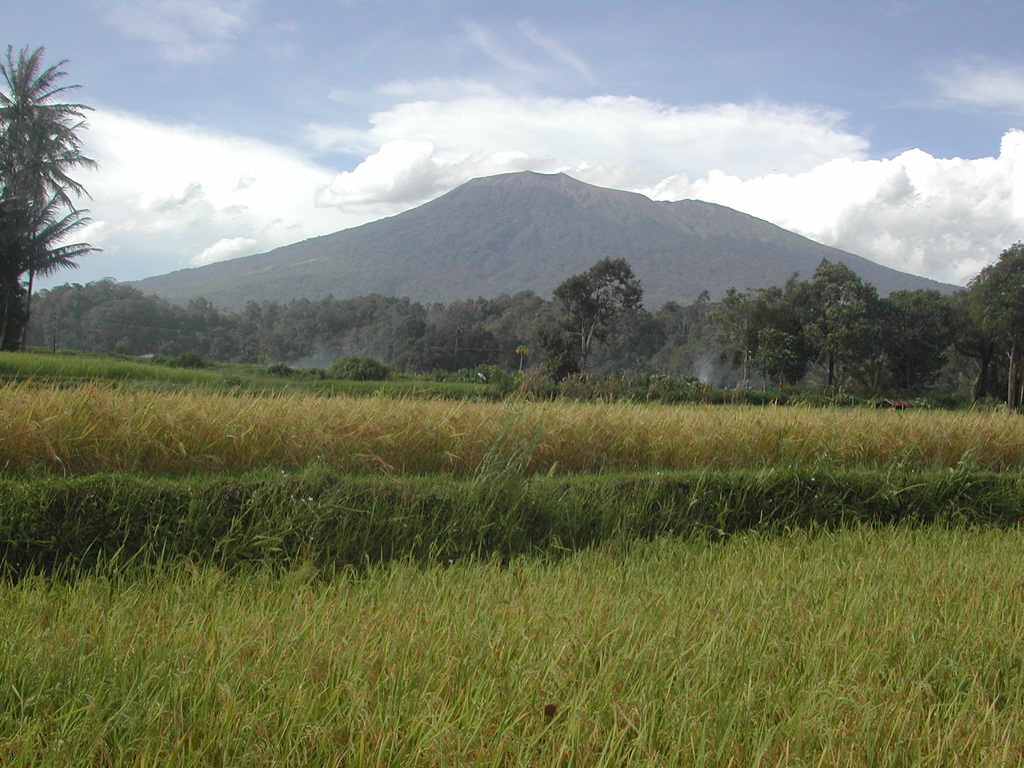 Marapi Marapi
Sunda Volcanic Arc
|
The Pusat Vulkanologi dan Mitigasi Bencana Geologi (PVMBG) reported that eruptive activity at Marapi (on Sumatra) was ongoing during 30 October-6 November. During 30 October-5 November daily white emissions rose as high as 300 m above the summit and drifted several directions. At 0544 on 6 November ash emissions rose 1.5 km above the summit. At 1500 that day the Alert Level was raised from 2 to 3 (on a scale of 1-4) due to increased seismicity and emissions and the public was warned to stay 4.5 km from the summit crater.
Source: Pusat Vulkanologi dan Mitigasi Bencana Geologi (PVMBG, also known as CVGHM)
|
Merapi (Indonesia) | 30 October-5 November 2024 | Continuing Activity Cite this Report Cite this Report |
 Merapi Merapi
Sunda Volcanic Arc
|
The Pusat Vulkanologi dan Mitigasi Bencana Geologi (PVMBG) reported that the eruption at Merapi (on Java) continued during 30 October-5 November. The SW lava dome produced 99 lava avalanches that traveled as far as 2.0 km down the Bebeng drainage on the SW flank. On 3 November one pyroclastic flow was recorded by the seismic network. The Alert Level remained at 3 (on a scale of 1-4), and the public was warned to stay 3-7 km away from the summit, based on location.
Source: Pusat Vulkanologi dan Mitigasi Bencana Geologi (PVMBG, also known as CVGHM)
|
Nevado del Ruiz (Colombia) | 30 October-5 November 2024 | Continuing Activity Cite this Report Cite this Report |
 Nevado del Ruiz Nevado del Ruiz
Northern Andean Volcanic Arc
|
Servicio Geológico Colombiano’s (SGC) Observatorio Vulcanológico y Sismológico de Manizales reported that eruptive activity at Nevado del Ruiz continued during 30 October-5 November. The number of seismic events associated with fluid movement increased in both magnitude and number compared to the previous week, especially from seismic signals related to pulsating ash emissions, but were variable between low and moderate levels throughout the week. Webcam images confirmed ash emissions associated with some of these events. At 0220 on 30 November an ash emission rose 1.8 km above the crater and drifted NE, E, and NW. Ashfall and sulfur odor was reported in the Lagunilla River area to the E. Seismicity associated with rock fracturing increased in both magnitude and number compared to the previous week, with depths less than 8 km below the summit. The largest event was M 2.5, recorded at 0055 on 30 October. Low-to-moderate thermal anomalies on the crater floor were identified in satellite data when weather permitted. The Alert Level remained at Yellow (the second level on a four-level scale), and the public was warned to stay out of the restricted areas around Arenas Crater, not to spend long periods of time on the Murillo-Cerro Gualí Road, and to avoid drainages in the high-threat zones.
Source: Servicio Geológico Colombiano (SGC)
|
Rabaul (Papua New Guinea) | 30 October-5 November 2024 | Continuing Activity Cite this Report Cite this Report |
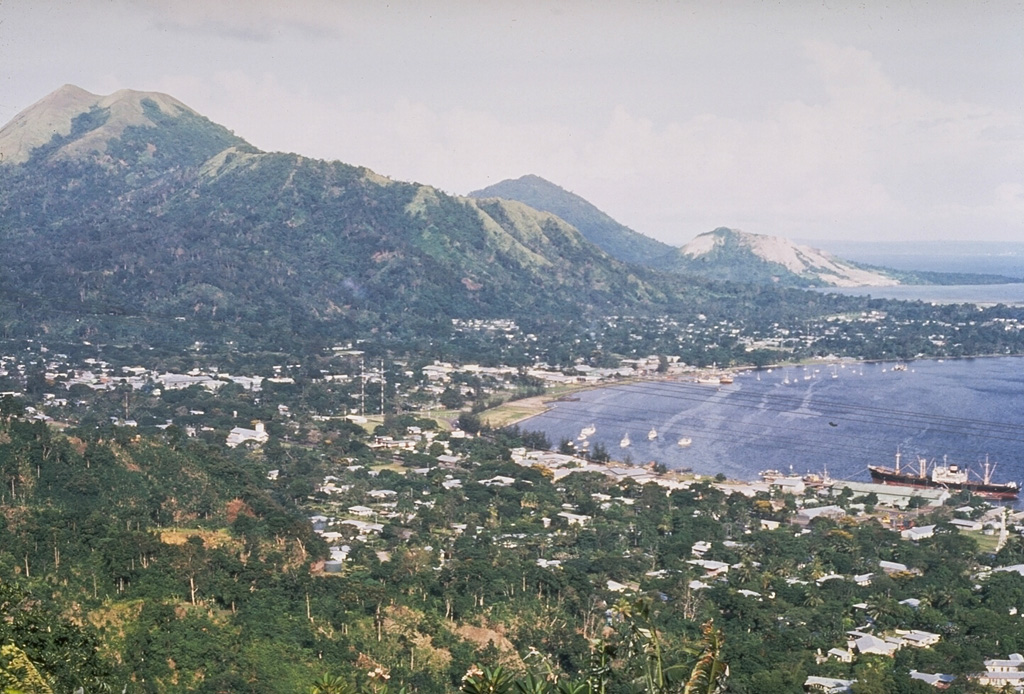 Rabaul Rabaul
Bismarck Volcanic Arc
|
The Rabaul Volcano Observatory reported that activity at Rabaul Caldera remained at background levels during 1-31 October. Fumarolic activity produced thin, white emissions from small fumaroles on the crater floor and inner walls. Seismicity included 11 high-frequency volcano-tectonic (VT) earthquakes, with nine located at depths of 1-9 km, primarily near the Vulcan and Tavurvur vents. Deformation monitoring revealed ongoing inflation since January 2024, with a cumulative vertical displacement of about 7 cm. Temperature measurements of two hotspots within the crater remained below 50 degrees Celsius, which is consistent with background levels. The Alert Level remained at Stage 1 (the first level on a four-level scale).
Source: Rabaul Volcano Observatory (RVO)
|
Ruapehu (New Zealand) | 30 October-5 November 2024 | Continuing Activity Cite this Report Cite this Report |
 Ruapehu Ruapehu
Taupo Volcanic Zone
|
GeoNet reported that minor unrest continued at Ruapehu as of 31 October. Te Wai a-moe (Ruapehu Crater Lake) has remained cool; however, monitoring data suggests that a slow heating trend is underway. The crater lake water temperature has increased from 8 degrees Celsius to 10-11 degrees Celsius since mid-October. Gas monitoring sensors have recorded low to moderate levels of sulfur dioxide (SO2) emissions, while volcanic tremor signals have also remained low. The Volcanic Alert Level remained at 1 (on a scale from 0-5) and the Aviation Color Code remained at Green (the lowest level on a four-color scale).
Source: GeoNet
|
Sabancaya (Peru) | 30 October-5 November 2024 | Continuing Activity Cite this Report Cite this Report |
 Sabancaya Sabancaya
Central Andean Volcanic Arc
|
Instituto Geofísico del Perú (IGP) reported that moderate levels of eruptive activity continued at Sabancaya during 28 October-3 November. A daily average of seven explosions were recorded, ejecting ash-and-gas emissions as high as 2.2 km above the summit. The emissions dispersed as far as 10 km in the SW, W, and NW directions. Seismicity included a total of 186 earthquakes associated with magma and gas movement, as well as earthquakes related to rock-fracturing processes inside or near the volcano. Slight inflation of the N sector of the volcano complex continued (near Nevado Hualca Hualca, located approximately 7 km N). Sulfur dioxide (SO2) emissions were classified as moderate, with an average of 745 tons per day. Additionally, a combined total of 24 thermal anomalies were detected in the area of the lava dome within the crater (with a maximum value of 4 MW). The Alert Level remained at Orange (the third level on a four-color scale) and the public was advised to stay at least 12 km away from the summit crater in all directions.
Source: Instituto Geofísico del Perú (IGP)
|
Santa Maria (Guatemala) | 30 October-5 November 2024 | Continuing Activity Cite this Report Cite this Report |
 Santa Maria Santa Maria
Central America Volcanic Arc
|
Instituto Nacional de Sismologia, Vulcanologia, Meteorologia, e Hidrologia (INSIVUMEH) reported ongoing eruptive activity at Santa Maria’s Santiaguito cone during 30 October and 5 November with continuing lava extrusion at Caliente dome. Daily explosions (a few per hour) generated gas-and-ash plumes that rose as high as 1 km above the dome and drifted several directions. The explosions and emissions generated short pyroclastic density currents (PDC) during 30-31 October. Effusion of blocky lava and collapses of material produced block avalanches that descended the flanks. Incandescence was sometimes visible during dark hours from avalanches of material at the dome as well as explosions. Ashfall was reported in San Marcos (8 km SW), Lome Linda Palajunoj (7 km SW), Finca El Patrocinio on 31 October.
Source: Instituto Nacional de Sismologia, Vulcanologia, Meteorologia, e Hidrologia (INSIVUMEH)
|
Semeru (Indonesia) | 30 October-5 November 2024 | Continuing Activity Cite this Report Cite this Report |
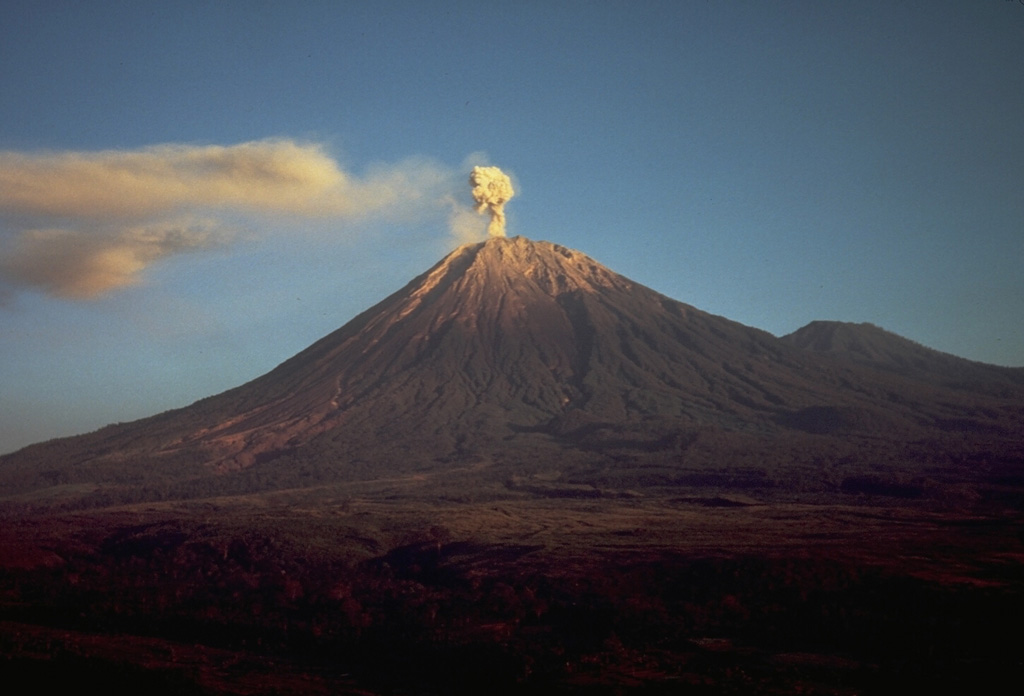 Semeru Semeru
Sunda Volcanic Arc
|
The Pusat Vulkanologi dan Mitigasi Bencana Geologi (PVMBG) reported that eruptive activity continued at Semeru during 30 October-5 November with several daily eruptive events recorded by the seismic network. Daily gray or white-and-gray ash plumes that were sometimes dense rose 100-900 m above the summit and drifted in multiple directions. Weather conditions sometimes prevented views of the summit. The Alert Level remained at 2 (the second lowest level on a scale of 1-4). The public was warned to stay at least 5 km away from the summit in all directions, 13 km from the summit to the SE, 500 m from the banks of the Kobokan drainage as far as 17 km from the summit, and to avoid other drainages including the Bang, Kembar, and Sat, due to lahar, avalanche, and pyroclastic flow hazards.
Source: Pusat Vulkanologi dan Mitigasi Bencana Geologi (PVMBG, also known as CVGHM)
|
Sheveluch (Russia) | 30 October-5 November 2024 | Continuing Activity Cite this Report Cite this Report |
 Sheveluch Sheveluch
Eastern Kamchatka Volcanic Arc
|
The Kamchatkan Volcanic Eruption Response Team (KVERT) reported that during 24-31 October lava extrusion continued at Sheveluch’s “300 years of RAS” dome on the SW flank of Old Sheveluch and at the dome at Young Sheveluch. This activity was accompanied by powerful gas-and-steam emissions. Thermal anomalies over the domes were identified in satellite images on 25, 27-28, and 31 October. Weather conditions prevented views on the other days of the week. The Aviation Color Code remained at Orange (the second highest level on a four-color scale). Dates are based on UTC times; specific events are in local time where noted.
Source: Kamchatkan Volcanic Eruption Response Team (KVERT)
|
Suwanosejima (Japan) | 30 October-5 November 2024 | Continuing Activity Cite this Report Cite this Report |
 Suwanosejima Suwanosejima
Ryukyu Volcanic Arc
|
The Japan Meteorological Agency (JMA) reported that eruptive activity at Suwanosejima's Ontake Crater continued during 28 October-4 November. Discrete eruption events were recorded at 0045, 0712, 1448, and 1658 on 29 October. Eruptions on 29 October produced ash plumes that reached 1-1.6 km above the crater rim. One explosive event, captured by infrasound monitoring equipment at 1606 on 2 November, produced white emissions that reached 300 m above the crater rim and drifted SE. A continuous eruption from 1230 until about 2204 on 4 November produced ash emissions to at least 1.2 km above the crater rim; the plume drifted SE. Tremor accompanied the eruption events and ashfall was reported by the Suwanosejima Branch of the Toshima Village Office (3.5 km SSW). The Alert Level remained at 2 (the second level on a five-level scale) and the public was warned to stay at least 1.5 km away from the crater.
Source: Japan Meteorological Agency (JMA)
|
![]() Download Smithsonian / USGS Weekly Volcanic Activity Report Network Link
Download Smithsonian / USGS Weekly Volcanic Activity Report Network Link

 Iya
Iya Kama'ehuakanaloa
Kama'ehuakanaloa Lewotobi
Lewotobi Taal
Taal Aira
Aira Ambrym
Ambrym Dukono
Dukono Ebeko
Ebeko Fuego
Fuego Great Sitkin
Great Sitkin Ibu
Ibu Kanlaon
Kanlaon Karymsky
Karymsky Lewotolok
Lewotolok Manam
Manam Marapi
Marapi Merapi
Merapi Nevado del Ruiz
Nevado del Ruiz Rabaul
Rabaul Ruapehu
Ruapehu Sabancaya
Sabancaya Santa Maria
Santa Maria Semeru
Semeru Sheveluch
Sheveluch Suwanosejima
Suwanosejima